- Home
- Palm Physique
- What Are Fronds?
- Frond Symbolism
Palm Fronds Meaning
Palm fronds meaning often relates to victory in battle.
Or sometimes celebrating success in negotiations. Many through the centuries used palm fronds to mean strength.
Peace is another symbolic use on occasion. A common misconception is that peace symbolism shows a dove holding a palm frond. But that's rare, doves usually carry an olive branch to represent peace.
Some of today's governments still carry that symbolic traditional aura.
- For instance some Arab governments use palm fronds in their official insignias. Other countries incorporate an entire Palm Tree for its Meaning.
- Yet, most of the time it's used to invoke the flora of the area.
Throughout history it's had different meanings, depending on current day vs and influenced by ancient history. So palm fronds have been used in many ways, sometimes meaningful. We'll go over the ways that demonstrate palm fronds have telltale meanings.
Feeling overwhelmed by so many palm trees?
You're not alone. We Understand your headaches! At Mission: Palm Trees you'll find clear answers to questions & Step-By-Step Guidance, from real people. With solutions to help. No puzzling shoptalk. No tiring research. So it's easy & fun for you.
Palm Fronds Meaning in Antiquity
Palm fronds meaning has historically been a symbol of triumphant victory. And strength. Particularly with the early Egyptians, Greeks and Romans.
They included palms in many of their coins, artwork, architecture and rhetoric.
For instance the Romans often honored an emperor with his image on a coin. He could be seen with palms incorporated into a headpiece, or on a shield. When this was done, palm fronds meaning was for his victories. It was usually for battle accomplishments. But could also relate to organizing alliances, or when negotiating with his staff.
Or as with the coin just below, the reverse side may show the image of a Roman god. Who might be holding a palm frond.
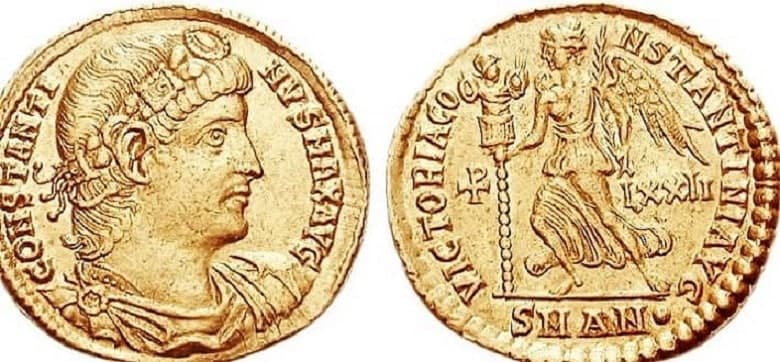 Coin Reveres Constantinus I - Reverse Side: Ancient God carries a palm frond in the left hand.
Coin Reveres Constantinus I - Reverse Side: Ancient God carries a palm frond in the left hand.Classical Egyptian Architecture Revered Palms
Egyptian architecture incorporated palms into their designs.
Consider the 2458–2446 B.C. Pyramid Temple of the Pharaoh Sahure ruins. The palm column might represent a palm's trunk. Since it's a pole-like structure. Date palms are inscribed as if tied to the pole's top. All in imitation of a palm tree.
The Egyptian use of palm-like columns typically express fertility, new life or eternal life. Some believe they also demonstrated Strength, Like Palms Have. Yet that's not truly verified, but it may make sense!
Originally it had eleven columns. All holding up a granite awning around the sides of a courtyard. That led to the temple's entrance.
While palm columns were likely used to signify certain aims, their specific symbolic meanings are debated.
 Palm Columns in Egyptian Temple Ruins
Palm Columns in Egyptian Temple RuinsCirca 2458–2446 B.C. in Abusir.
Among ancient Greek artifacts during the Byzantian Empire, are several spoons with engraved palm fronds.
This spoon has carved palm leaves on its silver bowl section. Possibly meaning the sustenance palms have given throughout the Mediterranean areas.
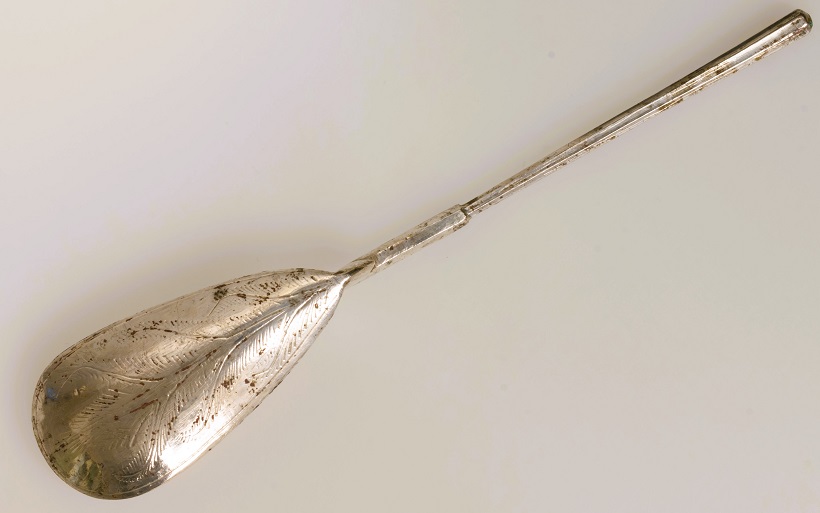 Used by Some in the Byzantine Empire
Used by Some in the Byzantine EmpireSpoon with Palm Fronds From the 5th–6th century.
Our Latest Article
-
Kinds of Palm Trees Florida Climates Support
Discover kinds of palm trees Florida has around every corner. Those natives & non-natives. See the region, height, appearance, cold tolerance & more.
Palms in Post-Civil War in the U.S.
After the Civil War Augustus Saint-Gaudens created a sculpture to honor General Sherman.
Now located in the Grand Army Plaza, Manhattan NY. Sherman is on horseback beside "Victory."
Her pose demonstrates the symbolic guiding force she provided as a token of peace. She holds a palm frond, for the meaning of victory.
According to The Met, "The principal model for Victory was Hettie Anderson..." She was an African American woman, an 1890s locally renowned favorite to sit as a model.
 Metropolitan Art's Copy of Victory
Metropolitan Art's Copy of VictoryHolding a Palm Frond
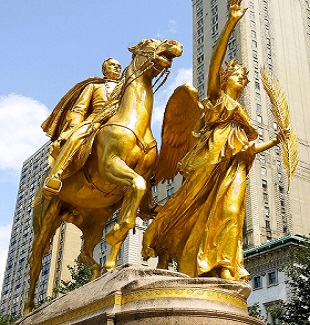 Sherman Tribute in Grand Army Plaza
Sherman Tribute in Grand Army PlazaNew York City
Practical Palm Frond Usage
for Writing in Ancient Times
In those former days, palm fronds meanings also held a practical sense.
Let's go back to the Sumerians sometime between 4000-3000 B.C.E. Written language, using a consistent illustrative system, cuneiform, is said to have started with them.
Afterwards, three forms of reading and writing developed: Hieroglyphics, Hieratic writing, and Demotic. Familiarity with using these writing forms was limited. Priests, scholars, scribes, and accountants had that knowledge, for use in their work.
Before China's invention of paper about 2900 B.C., In those times People Often Used Papyrus, the most widely used writing material. It's made from the Cyperus papyrus plant, a type of sedge.
Parts of Palm Fronds were used for writing & artwork in areas where they were readily available.
- India began using palm fronds as a paper-type of source about the 900s A.D. Buddhist monks found it useful.
- Nepal and Southeast Asia attached bundles of fronds into a book-like form.
- The palmyra (Borassus flabellifer) and talipot (Corypha umbraculifera) palm fronds were most commonly used for these purposes. These ancient palms were likely native to Southeast Asia, India, tropical parts of Africa, and the South Pacific. But really their indigenous beginning is unsure.
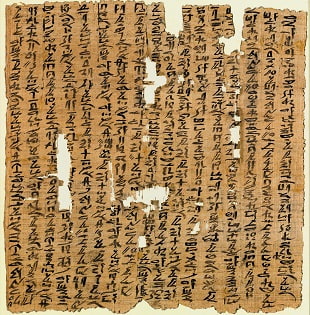 Hieroglyphics Written by Heqanakht
Hieroglyphics Written by HeqanakhtA "ka-servant" of a High Official
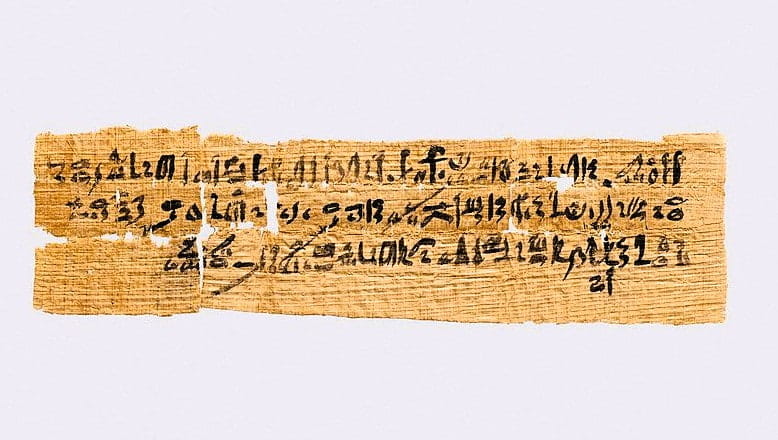 Letter in Hieratic Script on Papyrus
Letter in Hieratic Script on PapyrusThe easiest writing surface for many ancient peoples would be a palm frond. Dried out and smoked, frond surfaces could support writing or painting.
Today, using palms in paper making has been used experimentally in the pulp and paper industry.
- The rachis of Date Palm fronds are sourced for cellulose fibers. Then processed to be incorporated in softwood tree fibers to improve paper.
- Bagasse fibers from sugar cane is also added, making paper more Eco-friendly.
This type of paper is still in small quantity production. The purpose has been to evaluate the sustainability of palm frond paper, and other specialty paper markets.
Perhaps one day it will be more commonplace.
What Do Palm Fronds Mean in Different Religions?
For thousands of years, many religions have seen palm fronds as special symbols.
They often stand for big ideas like victory, peace, and life forever. They can also represent the connection between humanity and the divine presence.
The palm is important in many faiths. Yet its meaning for each faith can be a little different.
We'll now get into palm fronds meanings in various faith communities.

What is the Meaning of Palm Branches in Christianity?
In Christianity, palm branches are a reminder of Jesus's arrival in Jerusalem.
Crowds were on the roadside waving palm fronds to welcome him. The branches stand for victory and the triumph of spirit over death.
This event is celebrated on Palm Sunday. It points to the beginning of Holy Week and commemorates the final days before Jesus's crucifixion.
Another way palms are used is in Western Christian art. It shows those about to give their life for their faith holding fronds. Meaning that their spirit will overcome their desires in the world.
Why are Palm Fronds Important in Judaism?
In Judaism, people worship by using a palm branch, which is called a lulav.
Worshippers wave the lulav in prayers to give thanks to God for his blessings and for providing for them. They take this action when participating in the harvest festival of Sukkot. To express their thanksgiving and joy.
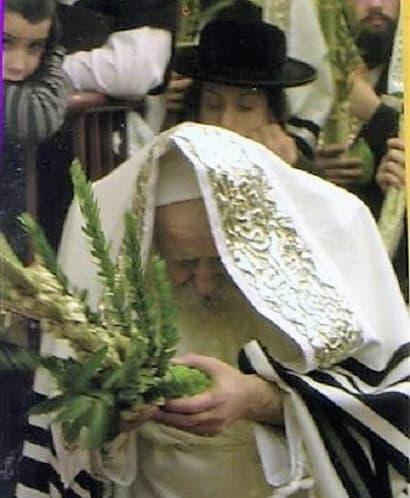 Festival of Sukkot in Montreal Canada
Festival of Sukkot in Montreal CanadaWhat do Palms Symbolize in Islam?
In Islam, the palm tree is a symbol of peace, rest, and hospitality.
- The Quran describes palm trees in Paradise (Jannah).
- The date palm is special for providing blessed food during the holy month of Ramadan.
- Palm trees around an oasis demonstrated that water was the gift of Allah.
Islamic tradition remembers how Muhammad built his home from palm materials, including the fronds of palms.
What is the Symbolism
of Palms in Hinduism and Buddhism?
In Hinduism, the palm tree stands for victory and success.
- The coconut palm is especially important as a sign of prosperity and continued family descendants.
- It refers to the spirit of overcoming difficulties.
- Fronds have essential roles in Hindu religious rituals.
In Buddhism, the palm tree represents spiritual growth and strong faith.
- Because of the palm tree's strength, Buddhists use it to mean awareness and stability in their beliefs.
- The leaves are a symbol of peace and overcoming challenges on the path to enlightenment.
How Did Ancient Religions View the Palm Tree?
In ancient Egypt, palm stems were a symbol of long life and eternal life after death. The god Huh was often shown holding a palm frond in one or both hands
For the Assyrian people, the palm was a sacred tree. They believed palms connected heaven and earth. They felt the goddess Ishtar's spirit came through the palms.
Concluding note on Palm fronds in Religion
Across varied faiths and ancient traditions, the palm frond stands as a powerful emblem of deeply held beliefs.
It consistently symbolizes victory, peace, and eternal life, connecting different cultures through shared spiritual values. The palm's enduring significance shows how nature can represent humanity's highest hopes for divine blessing and triumph.
REFERENCES:
Egyptian Columns: Forms and Meanings at worldhistory.org/Egyptian_Architecture/
Development of Paper in China at britannica.com/topic/papermaking
NYC Parks Department: Sherman Monument at nycgovparks.org/parks/central-park/monuments/1442
Roman Coins with Victory and Palms at forumancientcoins.com/numiswiki/view.asp?key=palm
State Symbols: Palm in Flags and Seals at netstate.com/states/symb/trees/fl_sabal_palmetto_palm.htm
Countries that Use Palms in Their Flags at flagstat.net/plant-symbols-flags/
Emblems with Palm Fronds Worldwide at crwflags.com/fotw/flags/sa.html
Palm Frond Writing at chinapreservationtutorial.library.cornell.edu/content/palm-leaf-manuscripts/
India Palm Frond Use at pbs.org/thestoryofindia/gallery/photos/10.html
Written Language History at ebsco.com/research-starters/literature-and-writing/early-writing-systems
IFLA: Traditional paper and manuscript preservation at ifla.org/traditional-paper-and-manuscript-preservation/
Metropolitan Museum of Art: "Early Buddhist Manuscript Painting: The Palm-Leaf Tradition" (2008 exhibition) at metmuseum.org/exhibitions/listings/2008/early-buddhist-manuscript-painting
Palm branch at en.wikipedia.org/wiki/Palm_branch
Spiritual Ask (2024, Feb 12) Palm Tree Symbolism Spiritual Meaning: Victory, Peace! at spiritualask.com/palm-tree-symbolism-spiritual-meaning/
Takeaway for Palm Fronds Meaning
In ancient times, people found value in palm fronds for many uses. Sometimes they attached a specific meaning, and other times a vague meaning to these fronds.
The Meaning of Palm Trees, the entire plant, was also given some signature emphasis.
Palm fronds still appear today, as a symbol. They're placed in emblems and flags of some nations, regions, and organizations. Saudi Arabia, Some South Pacific countries, Florida, and South Carolina state flags incorporate palm fronds or the whole palm tree to represent them as a tropical area that supports Palm Tree Growth.
Because of their value in providing for habitats, food, and support of local economies.







